
Compiled by Val Thomas with help and research completed by Brian Stevens. – St Ives Old Cornwall Society
Sometimes known as St Peter’s Street Methodist Church or Chapel or St Peter’s Street United Methodist Church and also recorded as Bank or Lower Wesleyan, Chapel Street
The Bible Christian Chapel in St Ives is centrally located on the corner of St Peter’s Street and Back Road East. This area is known as ‘Down’long’. There is limited parking in the area but there is an area at the front which is open to allow the congregation safe entry and exit. The chapel is now Grade 2 listed.
It is on the corner of St Peter’s Street which was originally known as Chapel Street and then Stevens Street. I find this confusing as there is another Chapel Street in St Ives where the old Teetotal chapel, now the drill hall is!
There was always great co-operation between all the St Ives chapels, but in particular with the Primitive Methodists.
1824 A chapel was built by the Wesleyans and had seats for 160. The lease was for 99years and was between Sir Christopher Hawkins and Thomas Bryant. The street we now call St Peters Street was once called Chapel Street and the chapel built by the Wesleyans was known as Bank or Lower Chapel. There were 2 Wesleyan chapels in the town at this time:
1814 There is evidence that the Bible Christians commenced their work a few years after the Napoleonic war ended in 1814. The early dissenters met in houses, later using a ‘Meeting House’ which was probably a workshop, sail loft or net loft. Their first recorded site which is in the history of St Ives Museum, was in the early St Ives Museum site which was a fish curing cellar and net loft.
1822 The Bible Christians had 18 women ministers and 23 men in their ministry.
1824 Quoted from papers which were written by Harold Franklin and collected by Brian Stevens record:
“Bible Christians arrived at St Ives about 1824 and services were held for some time at a loft where Island Road School is now. Later they moved to another loft more commodious with two openings, one in Fish Street, the other in Victoria Place now used as a carpenter’s shop. They then ventured in the building of a small chapel which was entered from St Peter’s Street. The door was in the far corner of the present building. The last enlargement was in 1858.” This building described as entering at Fish Street and Victoria Place is presumed to have been where John R. Cothey had his boat building workshop in 1948. This chapel was a small construction and the deeds for the building commence in 1824.
1829 The Bible Christians, originally called ‘Bryanites’ after their leader O’Bryan, commenced preaching in the town but following the difficulty of getting a suitable room this attempt ceased. They had used Mr Jenning’s loft, which being in a decayed state and filled with a dense congregation gave way, precipitating the preacher and congregation into the tubs of fish and oil beneath! (Jenning’s loft was in Market Strand and was used for large gatherings at that time. Market Strand is no longer mentioned but is part of where the Salvation Army citadel is now on Wharf Road near the new lifeboat house.)
1830 St Peter’s Street was known by the name of a family who lived there, so was known as Stevens Street.
1842 1st September. Papers recording the sale of the Mornington estate in 1904 mention: “ …. and on the south west, in part by the Bible Christian Chapel and school room, formerly leased to Thomas Bryant and in another part by premises formerly leased to Job Stevens, and which premises are subject to an indenture of lease, dated 1st September 1842.” The original chapel was about one third the size of the present one and had no balcony.
1849 Mr Beer commenced open air preaching, which was continued for several months. The old loft was repaired and again used for worship until Christmas 1858. In 1849 the chapel was mentioned in a missionary report … “..upwards of 4 converts being collected there at the first meeting.”
1850 4 more converts were mentioned in the Missionary Society report. There was a tea meeting to raise money which was presided over by Mr Thomas Leggo. It was held in a loft 150 feet long, kindly lent by Samuel Hocking, being fitted up by willing hands for the occasion. Both men and women are mentioned approvingly by William Beer who was there on the occasion. The profit of £15.00 was spent on rent and altering the chapel. A new chapel was also talked of on the occasion.
1851 There is a Chapel is shown as being in Back Road or Quay Street. The attendance on 31st March 1851 was 150 in the afternoon and 150 in the evening, the average being 140. The chapel was part of the Penzance circuit at that point and William Bees of 17, St Clare Street, Penzance was the minister. All streets led to the quay at that time and the land the chapel was on belonged to the Mornington Estate owned by Lord Bolton.
1853 The anniversary was celebrated on Sunday and Monday December 25th and 26th.
1853 or 4 The Bible Christian magazine of this year states that “We held the anniversary of St Ives chapel on Sunday and Monday December 25th and 26th, 1853. …. On Monday afternoon a public tea meeting was held in one of Dr Hocking’s large timber lofts, kindly lent for this occasion. About 190 persons took tea; after which a public meeting was held. …. we found in making up our accounts we had nearly £36 profit.” The sermons were preached by Mrs Roberts. The Hocking brothers had seine net lofts. Another portion says “… 3 fishing boats took missionary boxes to sea with them and gave a portion of their earnings to the missionary cause.”
1858 The Bible Christians bought the chapel for £105.00. According to Kelly’s Directory of Cornwall: the deeds state that there was a small chapel on the site.
1859 The chapel was rebuilt and enlarged, with a school room added, to seat 300 at a cost of between £400.00 and £500. The debt was now reduced to about £280 according to John Maynard. A building boom had caused the Down’long population to expand. This was due to the building of the Porthmeor wall to stop the sand drifting, which was begun in 1801. The chapel was said to be “not large enough to contain the congregation”.
1860 St Ives had 45 members in September.
1861 There were 296 members which increased to 447 in the next quarter.
1862 A manse had been obtained and the contents for it were written as a list

1863 Sarah Hutchins preached at St Ives.
1865 In the Bible Christian magazine for this year it states: “The anniversary of the St Ives chapel was celebrated on Sunday and Wednesday, December 18th and 21st, 1864….. The attendance was good, the influence rich and the collection encouraging….. The net proceeds are more than £18, being much in advance of last year.
St Ives had its own Bible Christian circuit which included Zennor, Tregarthen built 1833, Lady Downs with the chapel built in about1860 and Halsetown, built in 1832.
1865 In the circuit there were 2 ministers and 6 local preachers to serve 4 chapels and 1 preaching place. The circuit membership stood at 157 and there were 22 teachers and 130 scholars in the circuit Sunday Schools. Three fishermen are named on the trust for the chapel; William Jennings Mankey, William Clark Ephraim William Stevens. James Rich an engineer and John Major a butcher are also named as trustees.
1871 The chapel was again enlarged and altered, with new flooring and gas installed.
1878 The membership of the circuit was just 60. This was because Lady Downs, Halsetown and Zennor had no congregation worth naming! This was due to the decline of mining in the area.
1882 The chapels united to hold temperance meetings, with the first being held in the Bible Christian Chapel.
1885 – 1888 The Bible Christian magazine states: “A strenuous effort was made to renovate the chapel. It was in a comfortless, unsightly condition…. The friends were few and the funds very low.” A bazaar raised over £20.
1887 The chapel incorporated with Breage circuit. The chapel was closed for some weeks for thorough renovation.
1888 The chapel, nicely renovated, reopened on April 3rd. The singing seat was enlarged and a doorway opened at the side of the chapel into the schoolroom.
1891 Saw the incorporation of the St Ives circuit with Hayle. The Rev T. Nicholas was the minister.
1895 The Bible Christian Chapel was reopened after complete renovation. Mr W Down on Saturday delivered a lecture on “Elijah the Prophet of Mount Carmel”. Capt. J. Hollow presided.
1896 The Bible Christian magazine for 1996 state: “Renovations. A most pleasing change in its appearance. To say it was dirty is an understatement to put it mildly. It has been renovated at a cost of £34 without a bazaar or any other means. Such a sum is not raised without effort. …. The two country places ‘do not show life and vigour which we might delight to witness, but both are in the graveyards of the mining industry’….“
It appears the chapel had much support from the congregation and other local chapels but no big benefactor.
1896 January. An anniversary sermon was held to a large congregation. There was a choir under the leadership of Mr J. P. Craze. 1900 The Rev R K Baulkwill visited St Ives and preached on the Friday. The Rechabites met and marched to the chapel.
1902 May. A sale of work was held on May 29th in the Bible Christian Schoolroom in aid of the Primitive Chapel in Fore Street. There was much co-operation between these two chapels.
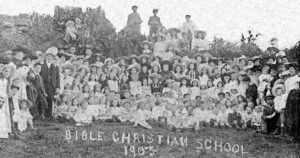 1905 – A gathering of the Bible Christian children on The Island in St Ives. (Image courtesy of Margaret Stevens)
1905 – A gathering of the Bible Christian children on The Island in St Ives. (Image courtesy of Margaret Stevens)
1906 There was a fundraising recital of the cantata “Belshazzar” to raise money for a new American organ.
1907 The renewal trustees are: Richard Care caretaker, William Curnow bootmaker, Matthew Stevens storekeeper, Edward Woolcock seaman, Matthew and James Barber, Humphrey Green, Richard Perkin, Edwin Perkin, Joseph Henry Curnow, and William ..?.. Junior and Senior, fishermen. It was about this time that adverts for the chapel change to St Peter’s Street United Methodist Church.
1918 New Trustees were added including Lander Elvin Comley outfitter and Joshua Daniel.
1922 Rev Marsden came to St Ives taking charge of Bedford Road, Chyangwheal and St Peter’s Street. He made connections with the parish church and gave the first address there after the lifeboat disaster. He left the district in 1944.
1923 July Nine new members had been received and a Bible class started. The church had been thouroughly renovated and all the labour given. The cost of the material had been met,
1924 January The St Peter’s Street church choir raised £40 by carol singing in aid of their new organ. A tender was accepted for the erection of the organ, which will begin almost at once.
1934 Article written by David Philp about the organ and organist, Edward Perkin.
1937 There are no fishermen as trustees.
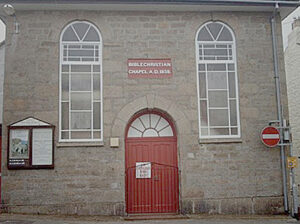
1962. The Ash Wednesday storms caused damage to the slate roof of the Primitive chapel so a funeral was held in the Bible Christian chapel instead.
1972 The chapel was listed Grade 2.List entry number 1136958
1981 Meetings were held in the Primitive chapel while the Bible Christian was being renovated.
1983 A Spring convention was held from Sunday 24th – Thursday 28th April.
1999 The chapel was again refurbished. Mr Probert raised money towards this by producing a book of the history of the chapel. The congregation at this time was under 80.
2008 A Missions Overseas fundraising event was held on the 150th Anniversary of the present chapel’s building.
2014 David Philp played the organ on 18th Aug and stated: “A lovely visit to play the organ here at St Peters Street St Ives. Organ built 1934 by the Sweetland Organ Company. The chapel was built c1858. John starts us off. The organist here, Mr Edward Perkin listens with interest &afterwards said it made a nice change to be able to ‘seat’ back and enjoy. With thanks to Edward for his welcome here today. This is my first visit here to this lovely little chapel and how well it is cared for and loved this place is. This is traditionally known as the Fisherman’s chapel. The tone of this organ is superb.”
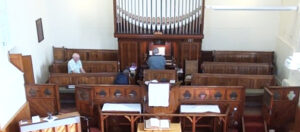 Edward Perkin at the organ. (Image: Margaret Stevens)
Edward Perkin at the organ. (Image: Margaret Stevens)
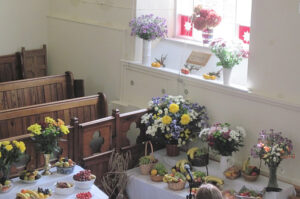 The children’s corner. 2014 (Image: Margaret and Brian Stevens)
The children’s corner. 2014 (Image: Margaret and Brian Stevens)
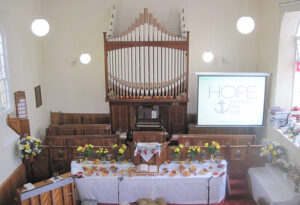 The Harvest Table (Image: Margaret and Brian Stevens)
The Harvest Table (Image: Margaret and Brian Stevens)
The organ particulars from Churches & Chapels & organs of St Ives – David Allan and Charley Nicholls
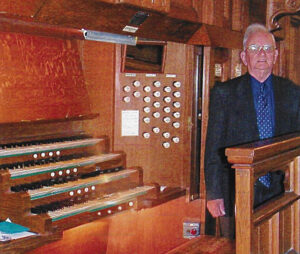 Organist James Cothie
Organist James Cothie

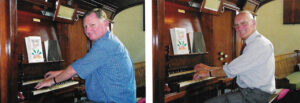 Peter James / Edward Perkin (Image from Churches & Chapels & Organs of St Ives. David Allan and Charles Nicholls)
Peter James / Edward Perkin (Image from Churches & Chapels & Organs of St Ives. David Allan and Charles Nicholls)
Organ specification: Great / Swell / Pedal
4 stops / 3 stops / 1
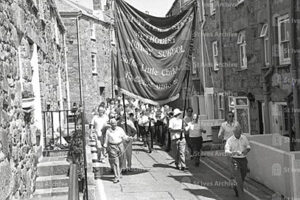 St Peter’s Street banner parade along Back Road. Front right: Edward Perkin, ‘Maffis’ with George White behind. Left: Willy Baumbach, John Ninnis and David Stratton among others. (Image: St Ives Archive)
St Peter’s Street banner parade along Back Road. Front right: Edward Perkin, ‘Maffis’ with George White behind. Left: Willy Baumbach, John Ninnis and David Stratton among others. (Image: St Ives Archive)
2023 The sale particulars from Berwicks
The chapel is up for sale by auction with a guide price of £175,000. It is 10 and a half by 7 and a half meters with a mezzanine (7.5m x 3.8m)
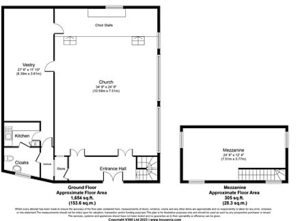 A plan of the chapel from the sale details 2023.
A plan of the chapel from the sale details 2023.
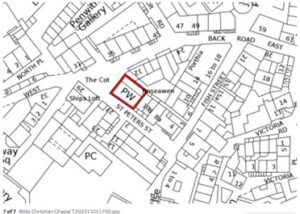 The schoolroom from the sale particulars. Berwicks 2023
The schoolroom from the sale particulars. Berwicks 2023
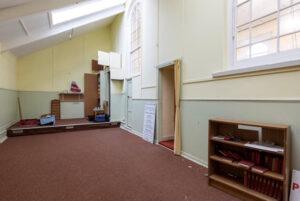
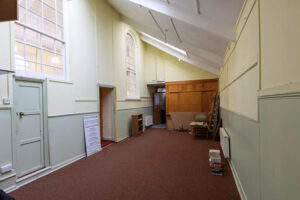
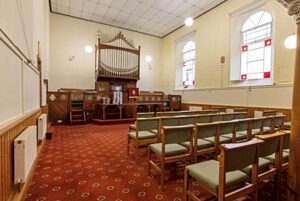
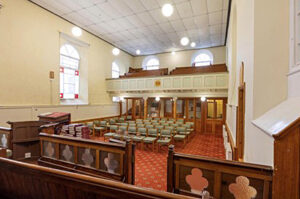
Resources used by Brian Stevens:
Cedric Appleby
The Bible Christian Magazine
St Ives Museum
Cyril Noall papers at Kresen Kernow or Cortney Library
Harold C. Franklin papers
Resources used by Val Thomas:
J.C C. Probert
The internet – biblechristian.org.uk etc
‘Find my Past’ newspaper reports

Lovely to read the story of the Chapel, thank you.
Is the Bible Christian chapel still meeting and functioning today?